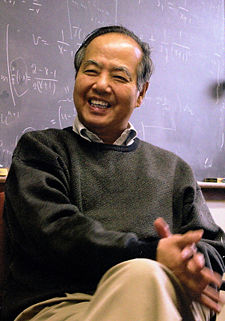Tsung-Dao Lee
| Tsung-Dao Lee | |
 T.D. Lee
|
|
| Born | November 24, 1926 Shanghai, China |
|---|---|
| Citizenship | United States |
| Fields | Physics |
| Institutions | Columbia University |
| Alma mater | Zhejiang University National Southwestern Associated University University of Chicago |
| Doctoral advisor | Enrico Fermi |
| Known for | Parity violation Lee Model Non-topological solitons Particle Physics Relativistic Heavy Ion (RHIC) Physics |
| Notable awards | Nobel Prize in Physics (1957) Albert Einstein Award (1957) |
Tsung-Dao Lee (T.D. Lee, Chinese: 李政道; pinyin: Lǐ Zhèngdào) (born November 24, 1926) is a Chinese-born American physicist, well known for his work on parity violation, Lee Model, particle physics, relativistic heavy ion (RHIC) physics, nontopological solitons and soliton stars. In 1957, Lee, at age 31, with C. N. Yang received the Nobel Prize in Physics for work on the violation of parity law in weak interaction, which Chien-Shiung Wu experimentally verified. Lee is the second youngest Nobel laureate, and Lee and Yang were the first Chinese Laureates.
Contents |
Biography
Lee's ancestral hometown is Suzhou, Jiangsu. He was born in Shanghai, China, and received his secondary education in Shanghai and Jiangxi. The first part of his university education (1943-1944) began at Zhejiang University, but was interrupted by Japanese invasion, so he continued at the National Southwestern Associated University (國立西南聯合大學) in Kunming the next year (1945). Lee went to the University of Chicago in 1946 and completed his PhD with Enrico Fermi. He then worked with collaborators on phase transitions in statistical mechanics and polarons in condensed matter physics. In 1953, he became an assistant professor at Columbia University, and worked mainly in particle physics and field theory. Three years later, at age 29, Lee became the university's youngest full professor. Over the years, Lee has pioneered and developed research ranging from symmetry violations in weak interactions to fields of high energy neutrino physics and RHIC physics. He remains an active member of the Columbia faculty and has held its highest academic rank, University Professor, since 1984. Currently, his interests have turned to the bosonic nature of high Tc superconductivity, the neutrino mapping matrix and new ways to solve Schrödinger equation.
Educational activities
Soon after the re-establishment of China-American relations with the PRC, Lee and his wife, Hui-Chun Jeannette Chin (Chinese: 秦惠莙; pinyin: Qín Huìjūn), were able to go to China, where Lee gave a series of lectures and seminars, and organized the CUSPEA (China-U.S. Physics Examination and Application).
In 1998, Lee established the Chun-Tsung Endowment (秦惠莙--李政道中国大学生见习基金) in memory of his wife, Hui-Chun Chin, who died 3 years earlier. The Chun-Tsung scholarships, supervised by the United Board for Christian Higher Education in Asia (New York), are awarded to undergraduates, usually in their 2nd or 3rd year, at five universities, which are Fudan University, Lanzhou university, Suzhou University, Beijing University and Taiwan Tsing Hua University. Students selected for such scholarships are named "Chun-Tsung Scholars" (莙政学者).
Personal life
Chin and Lee were married in 1950 and have two sons: James and Stephen. Lee reads whodunit novels when he does not work on physics. His English given name differs dramatically from the then-existing Chinese Romanizations, such as Wade-Giles and Gwoyeu Romatzyh. Tsung-Dao Lee is also known as T.-D. Lee.
Honours and awards
Awards:
- Nobel Prize in Physics (1957)
- Albert Einstein Award (1957)
- G. Bude Medal, Collège de France (1969, 1977)
- Galileo Galilei Medal (1979)
- Order of Merit, Grande Ufficiale, Italy (1986)
- Science for Peace Prize (1994)
- China National-International Cooperation Award (1995)
- Naming of Small Planet 3443 as the T.D. Lee Planet (1997)
- New York City Science Award (1997)
- Pope Joannes Paulus Medal (1999)
- Ministero dell'Interno Medal of the Government of Italy (1999)
- New York Academy of Science Award (2000)
- The Order of the Rising Sun, Gold and Silver Star, Japan (2007)
Memberships:
- National Academy of Sciences
- American Academy of Arts and Sciences
- American Philosophical Society
- Academia Sinica
- Accademia Nazionale dei Lincei
- Chinese Academy of Sciences
- Third World Academy of Sciences
- Pontifical Academy of Sciences
Bibliography
- Lee, T.D. (1981). Particle Physics and Introduction to Field Theory. Newark: Harwood Academic Publishers. ISBN 3718600323.
- Lee, T.D.; Feinberg, G. (1986). Selected Papers, Vols 13. Boston; Basel; Stuttgart: Birkhauser. ISBN 0817633448.
- Lee, T.D. (1988). Ed. R. Novick: Thirty Year's Since Parity Nonconservation. Boston; Basel; Stuttgart: Birkhauser. ISBN 0817633758.
- Lee, T.D. (1988). Symmetries, Asymmetries, and the World of Particles. Seattle: University of Washington Press. ISBN 0295965193.
- Lee, T.D.; Ren, H. C.; Pang, Y. (1998). Selected Papers, 1985-1996. Amsterdam: Gordon and Breach. ISBN 9056996096.
- Lee, T.D. (2000). Science and Art. Shanghai: Shanghai Scientific and Technical Publisher. ISBN 7532356094.
- Lee, T.D. (2002). The Challenge from Physics. Beijing: China Economics Publisher. ISBN 7501756228.
- Lee, T.D.; Cheng, Ji; Huaizu, Liu; Li, Teng (2004) (in Chinese). Response to the Dispute of Discovery of Parity Violation. Lanzhou, Hong Kong: Gansu Science and Technology Publishing House. ISBN 7542409298.
See also
- Lee–Yang theorem
External links
- T.D. Lee's English Home Page
- T.D. Lee's Home Page at Columbia University
- Nobel bio
- Brookhaven National Laboratory: Tsung-Dao Lee Appointed as Member of the Pontifical Academy of Sciences
- Celebration of T.D. Lee's 80th Birthday and the 50th Anniversary of the Discovery of Parity Non-conservation
|
||||||||
| Persondata | |
|---|---|
| NAME | Lee, Tsung-Dao |
| ALTERNATIVE NAMES | 李政道 (Chinese); Lee, T.-D. |
| SHORT DESCRIPTION | Nobel Prize-winning physicist |
| DATE OF BIRTH | November 24, 1926 |
| PLACE OF BIRTH | Shanghai, China |
| DATE OF DEATH | |
| PLACE OF DEATH | |